English Longhorns
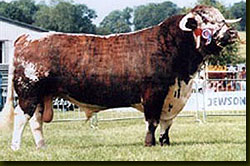 |
 |
| Llanthrothy Kestral |
Fishwick Kinsman 2711 |
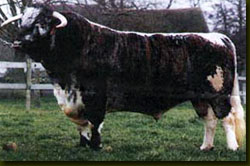 |
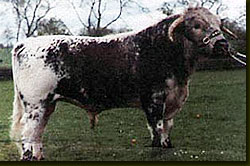 |
| Colaba Krypton
3201 |
Honeywood
Edmund 1704 |
 History of the English Longhorn
History of the English Longhorn
Bakewell and his contemporaries were men of great stubborn and social vision. During this period of their evolution Longhorns were bred for large carcass's, with a high percentage of fat to muscle ratio. Horn shape and size were also improved to meet the demand for buttons, cutlery handles and slivers for lamp shades. But, as has happened for millennia, animals were virtually crafted to suit the every day needs, fashion and affluence of the human population. Lean meat was in demand rather than fat, glass took the place of horn slivers for lamps and bone and china were used for buttons and cutlery handles. The other Shorthorn breeds which the "Old Longhorn" gave its best genes to rapidly superseded the parent by becoming specialist lean beef and high milk yielding machines.
By the 1880's the reign of the Dishley, Improved, Leicester and other Longhorn off shoots came to a sudden end. Within a decade or so only a few remnant herds of pure Longhorns remained in the stewardship of a few dedicated and traditional breeders. We rightfully give so much credit to Bakewell for his dedicated breeding policies but we should also extend this credit to the handful of breeders who defied the evolution of the new Shorthorn, possibly at great financial and social status loss, and kept intact enough genetic diversity to allow the English Longhorn to start its comeback as one of the fastest growing cattle breed societies in the UK today, (2004) having nearly 450 registered herds.
One of the great Australian icons, R.M. Williams, has graced his brand name and fashion label with the head of a Longhorn, this is now famous throughout Australia and the world. The head of the longhorn also features on the utes of the rural youth of Australia and has resurged in popularity.
 Characteristics of the English Longhorn
Characteristics of the English Longhorn
English Longhorns are large beasts, good milkers and very adaptable to climatic change. Their meat is fine grained and has a good sweet flavour with an acceptable distribution of fat. They are the breed that invented the traditional 'roast beef', later incorporating Yorkshire pudding. The eccentric King Charles II was inspired by Longhorns to name some of our cuts of beef. During one of his frivolous moments he looked at his plate and said; "Fond of all of you as I am, yet I have a still greater favourite, the loin of good Longhorn beef". He then reached for his sword and said; "Therefore good beef roast I knight thee, 'Sir Loin', and I proclaim that a double loin be know as a 'Baron'.
Many producers in the UK market their own Longhorn beef through specific brands and outlets as well as fresh and frozen pre-packed orders from farm. Unfortunately here in Australia misinformed multinational supermarkets believe that all beef should come from cattle of one coat colour, polled, and with meat lacking marbling and unaged. This attitude has led to beef consumption dropping by over 30% in as many years. An entire generation has never known what real beef should taste like.
In fact most beef eaten is like a sock with
gravy poured over it to give it some flavour.
Hopefully this mass produced bulk food mentality will change
when consumers are given other alternatives, as is happening
in the UK where demand for English Longhorn breeding stock
has outstripped supply. Registration of bulls is
conditional on the animal reaching a determined weight by
one year of age. Due largely to these characteristics
as well as consumer demands for open grazed husbandry,
Longhorns have moved from Rare Breeds status several decades
ago to numerically overtaking the "shorter horn" and "mid
horn" in the UK. The wheel of evolution is never
static and this classic example highlights the importance of
maintaining the diversity of breeds we still have under the
umbrella of Rare Breed Trusts around the world.
 My Association with the English Longhorn
My Association with the English Longhorn
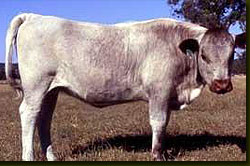 |
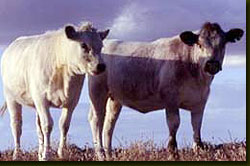 |
| English Longhorn heifer (Sire Llantrothey Kestral) |
English Longhorn heifers Ash (Sire Fishwick Kinsman) Anzac (Sire Llantrothey Kestral) |
During a more recent visit to the UK (1999) I saw several herds of cattle and met several of their owners, the Messrs Henson (Bemborough ), Quinn (Harford), Stanley (Blackbrook) and Harrison (Settrington). Having an attitude that nothing is impossible I decided that I would import semen into Australia.
The UK, quarantined with 'Mad Cow' disease, greatly limited the number of bulls that were eligible to only three, which was better than one as was the case with the last known attempt in 1980. After a year of frustration, expense and stubborn determination on my part the goal seemed accomplished and the semen was to arrive in late 2000. However it didn't get to the airport because of the outbreak of Foot and Mouth Disease. It now seemed an impossibility, but after another year of testing, talking and paper crunching and then one of the three bulls was found to be ineligible. Semen from Fishwick Kinsman and Llantrothry Kestral arrived in Melbourne at 6.20am on Saturday 12th January 2002. Unfortunately it could not be picked up for another week because someone signed a quarantine paper on the wrong line so another had to be issued from the UK.
In July 2002, 10 cows of mixed but
predominately shorthorn origin were inseminated as the
result of a synchronised programme. The first of four,
half English Longhorn calves arrived on 24th April
2003. Two more heifers and a bull were to
follow. The calves, nine months later have met, and in
the case of two of the heifers, exceeded all
expectations. Six more heifers have been inseminated
to calve in April-May 2004.
 The Challenges Ahead
The Challenges Ahead
There are English Longhorn cattle in North America as well as semen and embryos originating from the Toddington herd. New Zealand also has a few graded up animals and it could well be that there are more in Australia other than the three near Exeter in NSW, and mine in WA. The challenge now will be to obtain more semen from overseas from unrelated sires, which I suspect will be difficult. The English Longhorn Council are not very interested in puffing sires into quarantine for months, at great cost, to meet our import protocol, and then only sell a few straws.
I suspect also, that one of the concerns of the English Council is that, if we upgrade to "pure-bred" status eventually semen could be imported back to the UK. I understand and respect this concern, but there are times in our lives when we are compelled to initiate actions which we don't like in order to have the diversity of plants and animals for the benefit of other generations. We need purity in breeds but not to the extent of risking extinction.
With the world having to face new threats to our animals through disease, bio-terrorism, poverty, climatic change and land degredation, we all need to highlight the hidden beneficial characteristics of our breeds. Genetics from the North Ronaldsay breed of sheep, for example, living on the Orkney Islands whose diet consists of seaweed and salty water, could one day contribute to the saviour of Australia's sheep industry with so much of our land and water becoming saline, particularly in Western Australia.
Donald L Cochrane
Extract from article written for the Rare Breeds Survival Trust of Australia Magazine in February 2004.

Donald Cochrane with Huntsham Cardinal
(owned by John & Pat Stanley, Blackbrook Stud, Leicestershire)

